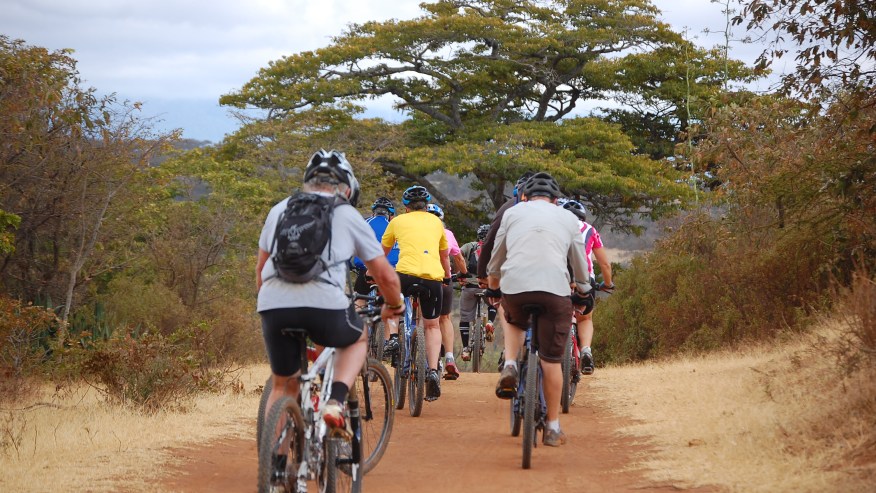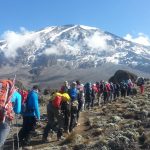Lake Manyara National Park
Lake Manyara, Size: 330 sq km (130 sq miles) of which 200 sq km (77 sq miles) are
lake when water levels are high
Established: 1960
Distance from Arusha: 126 km (78 miles)
Description:
Lake Manyara National Park is one of the smaller national parks in Tanzania but still offers beautiful landscapes and is home to an interesting collection of wildlife. The lake itself is a soda lake / alkaline lake and reaches a maximum depth of 3.7 m. The vegetation changes from ground water forests to flood plains and finally to acacia wood plains.
Highlights:
For bird enthusiasts this park is truly rewarding as it is home to over 400 species of birds. Other inhabitants of the park include elephants, buffaloes, hippos, baboons, waterbucks, impalas, giraffes, zebras and wildebeests. The park has an abundant population of leopards but sightings are rare due to the thick vegetation. With a bit of luck visitors can catch a glimpse of the renowned “tree climbing” lions.
Located on the way to Ngorongoro Crater and the Serengeti, Lake Manyara National Park is worth a stop in its own right. Its ground water forests, bush plains, baobab strewn cliffs, and algae-streaked hot springs offer incredible ecological variety in a small area, rich in wildlife and incredible numbers of birds.

Activities:
Mto Wa Mbu Village Walk
The bustling farming community of Mto Wa Mbu, located between Manyara and Ngorongoro, is home to around 18,000 people. Spend half a day here with a knowledgeable local guide and you’ll discover a side of Tanzania that many visitors miss.

What to expect during your village
A melting pot of cultures, Mto Wa Mbu is thought to be one of the only places in Tanzania where there are representatives from all 120 tribes living happily side by side. Although the name translates as ‘Mosquito River’, due to the permanent water source in the village, we fortunately didn’t see many mosquitoes.
Your guide is very likely to be from the village itself so you will have a unique opportunity to see the community through his eyes. Tours last around 2–3 hours, but are flexible. During your visit you’ll get a good feel for the social side of the village – the farms and the milling machines, the schools, markets and churches. Your guide will happily answer any questions you might have, and will help you to gain an understanding of the inner workings of this typical Tanzanian community.
You’ll likely start in the village banana plantation, where they grow more than 30 different varieties of bananas. As well as finding out how this staple fruit is grown, you’ll hear about the different uses of the plant as a whole, from food to materials for building and art.
Next you might visit a youth art project, and learn about the different painting styles and techniques. The artists are happy for you to ask questions and take photos, and while there are opportunities to purchase their artwork, which makes wonderful souvenirs, we were impressed that there was no hard sell or pressure to buy.
We then visited a wood workshop, where you can watch skilled members of the Makonde tribe carefully carving intricate figurines, masks and household objects. They’ll show you the different types of wood and finishings, and explain some of the historical and cultural meanings behind the carvings. You can even have a go at doing some carving yourself! Again, there are opportunities to purchase carvings should you wish, but with no hard sell or aggressive haggling, which we found very refreshing.
Moving on, you’ll come to a local ‘bar’ to try mbege, the traditional banana and millet beer that is brewed and drunk mainly by the Chagga tribe. The process of making this brew is quite labour intensive, and the beer is usually served in one large cup, which is passed around the group, and refilled as needed.
Your tour will finish in the bustling local market, where you can wander around stalls selling fruit and vegetables stalls, spices and meat. Your guide will stop and explain points of interest, and give you the opportunity to try and smell a variety of foods. A real treat for the senses!
Biking at Mto Wa Mbu village

You will enjoy a 2-hour mountain bike ride through the farming village of Mto Wa Mbu. On this ride, you visit local farms, schools, churches, milling machines a local bar and enjoy the sights and sounds of this vibrant village.
- Equipment: Merida and Titan mountain bikes and helmets
- Strenuousness: medium
- Time: morning or afternoon

About the Lake Manyara Treetop walkway
Highlights of the Lake Manyara treetop walkway
- First canopy walkway in Tanzania!
- 370m long, up to 18m high
- Birds-eye view of Lake Manyara’s surrounding forests
- Likely to see monkeys, birds & other wildlife down below

A different perspective with the treetop walkway!
The Manyara treetop walkway or canopy walk is the first and longest treetop walkway in Tanzania. Walk among the treetops and experience the untouched nature of the forest and its wildlife from a unique perspective.
The canopy / treetop walk is 370 long and reaches a height of 18m above groud. It’s only opened for a few years so it’s quite a new activity. The walkway consists of a series of bridges. Each of the bridges end on a viewing deck situated around treetrunks. These treetop platforms are perfect places to stop and view the surroundings or take a photo (as we did)
What to see on the canopy walk
Next to the beautiful forests you’re very likely to encounter more than a few blue monkeys (you guess which part is blue) and baboons who love to use the canopy as their playground. Apart from monkeys you can come eye to eye with a variety of birds such as the silvery-cheeked hornbill and several butterflies. If you’re lucky you might even see some of the bigger wildlife that hides in Lake Manyara’s forests.
Where is the treetop walkway
The canopy walk / treetop walkway is located right at the entrace of Lake Manyara National park which makes it a great addition to your safari and lets you have a different perspective on it’s wildlife below. This tour is not done seperately but as an addition to a trip.
The whole route can take around 30-50 minutes. It is ment to be a relaxing activity to enjoy the surroundings of the forest and its wildlife. If you rush the bridges you will be done quite fast.








